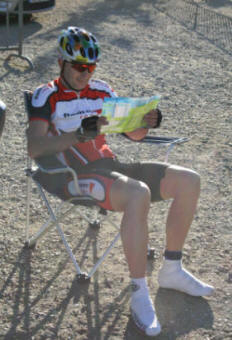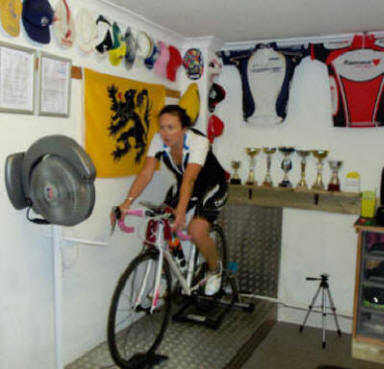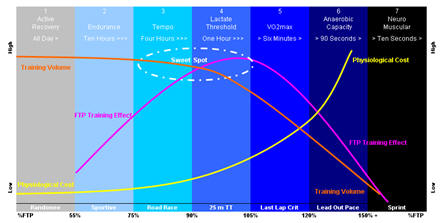Training Methodologies

Studies have indicated that by undertaking a focused, structured, individualized training program, VO2max can be increased by 15 to 30% over a 3 month period and up to 50% over 2 years!
Obviously the later figure is based on untrained athletes or someone new to the sport.
A world champion cannot be expected to increase their VO2max by 50% unless they resort to the old EPO or other dodgy practices.
Anyway, whatever you do, you need a plan. And that starts by sitting down and doing your research. Unstructured training will lead to unstructured performances; and unstructured performances will only lead to inconsistent results, how can it not? So a plan it is then!
The Benefits
Focused training
can lead to the correct metabolic adaptations,
which include changes in lactate removal. Being able to metabolize
lactate will seriously contribute to your
overall ability to perform at a higher level of VO2max for longer periods of
time.
With the correct training, changes also be made to occur in how your lipid metabolism behaves. Enabling extra energy Calories to be provided from the fat reserves, found in abundance around your body!
These Calories supplement those from glycogen and glucose, at specific VO2max levels, supporting longer durations of exercise to fatigue. We cover fat metabolism in other factsheets; a link will appear here soon!
Correct training also results in physical changes taking place in the muscles themselves. This is clearly explained in our Performance Programmes or if you should come for one, a Performance Test. Optimizing muscle, mitochondrial and enzyme development will seriously improve their tolerance for the stresses of prolonged exertion and will obviously, through sustainable overloading, delay their time to fatigue.
It's important to ensure that the strengthening of the connective tissue between muscle fibers, which translates into less microtrauma, or post exercise discomfort to give its less scary term, is managed in a controlled and structured manner. Nothing should be haphazard about your training or your race preparation. Success is all about doing the right things, in the right order, at the right time.
Not every training session in your program needs to stress the cardiovascular system to its limit. In fact successful programs are balanced with at least two days per week at less than maximal cardiovascular intensity to allow mental and physical recovery. Although it may not seem like it sometimes.
At time you will need to, or be forced, to take a break. There is obviously a drop off in metabolic adaptations within a few weeks of stopping training, although changes in numbers of muscle capillaries and skeletal and cardiac muscle fiber size are thought to decay more slowly.
What this means, is that you can quickly get back to where you were, with a few key workouts of the right intensity, for the right duration, at the right time. Of course, with the right recovery and adaptation phases built in to your return programme.
Training Intensity
Is more, better? Not necessarily.
Although the exact optimum for training intensity is unknown, and obviously varies between individuals, it is generally accepted that maximum aerobic improvement occurs at 85% VO2max (approximately 90% of your max heart rate).
Regular training above this level can increase the potential for injury without a corresponding increase in cardiovascular or musculoskeletal training benefits. Recovery and adaptation are as important, if not more important than your effort intensity and duration.

Nice steady riding ~ the calm before the storm...
It has been demonstrated that lower levels of exercise, around 60% max heart rate for 45 minutes or more, will at least maintain general cardiovascular conditioning.
The classic (old school) "long slow distance" approach to endurance training where your maximum heart rate is always limited to 60 to 80% VO2max will not optimize your personal performance for high level aerobic events. If you want to race fast you have to train fast.
A recent study assigned 15 women to either a low intensity (132 beats per minute) or high intensity (163 bpm) group, exercising for 45 minutes, 4 times a week. At the end of the programme there was found to be an increase in VO2max for members of the high intensity group, but not the low intensity one. Hardly surprising!
However, during the early days of training we are not attempting to boost our VO2max, we are attempting to train our bodies to "spare glycogen" and to get used to three to four hours in the saddle.
We are not building VO2max but we are building the conditions for VO21max to be expanded at a later date. So some "slow" riding is required to lay the groundwork for the chaos to come.
Everyone thinks we are riding slow to "burn fat". This isn't strictly true. We do burn fat, if we ride slowly enough, but that's because we are sparing glycogen. It's a bit cause and effect and "semanticky" but there is a difference.
Once you can acknowledge or understand the difference between cause and effect, training principles and why we do what we do, become a little clearer. Only a little, mind. Some things just have to be accepted as a given; we just don't know. Yet.
Training Duration
There is no easy answer to the optimum duration for a high intensity
training session, as all training is an interaction between intensity and
time. It's the manipulation of the variables, and the recovery in
between that brings improvement. Good programmes bring
sustainable improvement; bad ones leave you burnt out half-way
through the season.
Ten minutes at 80% maximum heart rate will be of some benefit to you, but thirty minutes will be better.
Sixty minutes could be twice as beneficial than thirty; but two hours are not twice as beneficial as one. There is clearly a point at which the negative effects of exercising at such a high level outweigh the benefits. At some point there is a case for "less is more".
For aerobic training at less than 90% maximum heart rate it makes the most sense to look at the duration of the planned event.
To give you confidence in your abilities and your preparation, why not train for a duration equal to that of the event you are targeting plus, possibly, an additional 10%. Just to prove you can. But only to a maximum of five hours. If you can ride for five hours, you can ride almost anything.
And you only need to do it once; twice maximum. Once you get to a certain distance, it becomes a case of riding that distance more efficiently and effectively.
So now we know we have the endurance capabilities, we can SLOWLY, build up the speed necessary to race at this level. You do this by riding shorter, but faster, then resting. All you need to do is slowly make the rest periods shorter, until all the effort bits join up!
Training Frequency
It appears that maximum aerobic conditioning (increasing VO2max) occurs
with three workout days per week. It is recommended that
recovery and adaptation takes place for two to three days
per week to allow for muscle and ligament repair, and decrease the risk
of cumulative physical stress. Personally, I always
prescribe one day of complete rest; walking the dog at the most.
Interestingly, it appears that these three days per week will maximize aerobic conditioning equally in any combination ~ three days in a row with four off, alternating days, or any combination thereof. It all depends on your constitution, lifestyle and personal preference.
Studies on maintaining the benefits of aerobic training revealed that a 66% reduction in training frequency, going from 6 days a week to 2 days a week but keeping the same intensity for each individual workout, maintained gains previously made.
So once you've got it, you can keep it, by doing less. When you've maxed out your potential there's no need to keep doing the same thing. It's a poor return on investment.
You can cut a 60 minute, 6 day per week program to 60 minutes, twice a week, perhaps even to a 30 minute session four times a week, and still maintain your aerobic fitness level. This is good knowledge to have.
However, fitness levels cannot be maintained by cutting the intensity of the 60 minute session and keeping it at 6 times per week. If intensity is held constant, the frequency and duration of exercise required to maintain fitness, are much less than the effort needed to attain that fitness level in the first place.

Give recovery the same attention as your intensity
full on or full off...
That's why, once we have established an endurance base we can cut back the distance to maintain it, then go off and do some speedy-power type training. All we need to do then is to maintain our endurance through the race season, by using one day a week to do a long, race-distance type, ride. Or you could just do a race!
Methods of Training
Training needs to be structured
round the intensity and duration of your
planned sporting objective or event. If your training doesn't have an
element of specificity to it, then how can you be assured of success.
If you are doing an event that might end in a sprint, train for sprinting;
if it's on a lumpy course, find some hills!
Anaerobic exercise (oxygen independent) is generally less than 60 seconds in duration and is mainly fueled by the anaerobic, ATP Creatine Phosphate system.
Training focused on anaerobic activities will enhance the ATP and CP energy transfer pathways as well as improving the tolerance for, and clearance of, lactate.
Aerobic training (oxygen dependent) provides its benefits by improving the cardiovascular and oxygen delivery systems to the muscle cell. These include improvements in both cardiac output, the amount of blood pumped by the heart per minute, and at the muscle fiber level there is an increase in the extraction of oxygen from the blood cells in the capillaries.
In addition, there is an improvement in the efficiency of the cellular metabolic pathways which convert glucose into ATP. Which is why we ride steady, for portions of the winter.
As the level of exertion increases, there is a slow transition towards anaerobic metabolism in the muscle. There are always areas of relatively lesser perfusion within the muscle that are functioning anaerobically. So even at 50 to 60% VO2max some anaerobic conditioning is occurring.
At 85% VO2max, the "anaerobic threshold" for most individuals, there is an abrupt increase in anaerobic metabolism throughout the entire muscle.
Even though some cross training of the anaerobic systems takes place during exercise at 60 to 80% VO2max, a sprint performance training program needs to include exercise sessions above 85% VO2max.
We do these once we are into the racing season. Obviously, long slow distance work is good training for aerobic, endurance events, but it will not improve your sprint performance.
Both aerobic and anaerobic exercise sessions need to be included in a training program. It is the balance of the amount of each type of exercise which determines its suitability for the competitive event for which you are training. We'll cover this in another article.
Interval Training
Interval training refers to sandwiching periods of intense physical
activity between periods of recovery, to allow longer periods of
training time at your peak performance levels.
One study in runners demonstrated that continuous, maximal performance levels could be sustained for only 0.8 miles before exhaustion occurred, while a similar level of peak exertion could be maintained for a cumulative distance of over 4 miles when intervals were used.
High intensity sprint intervals involve significant lactate build up and basically train the ATP and CP systems. It is recommended that the duration of the training interval should be increased by 1 to 5 seconds over the usual sprint distance.

When tweaking them the exercise intensity or maximum effort should remain unchanged, while the recovery period should be at least three times longer than the training interval.
Longer intervals, up to several minutes, produce significant lactate build up along with stressing the anaerobic metabolic pathways. To train for these several minutes of maximum output intervals, you should sub-divide the distance, or time being trained for, and the training effort should be fully focused on that shorter distance. When the quality drops you stop.
So, if you are new to the sport and training to complete a ten mile TT in thirty minutes, then if you can't ride one mile in three minutes, how will you ever do ten in thirty?
So ride one mile in three minutes, well within your capability, have three minutes rest, then ride another. Then build up from there. We cover this elsewhere as we are only showing concepts at this early stage. But I'm sure you can work it out for yourself.
Obviously this extrapolates out to any distance and any speed or time.
But on no account do intervals unless you really understand them. Please ask someone first!
Training program drop out rates can double when intervals are used, so they should be used judiciously. They are only to be used at specific times.
Consider them twice a week during your peak season, and separate each session by at least 48 hours to allow adequate recovery. If your long ride is on the weekend, Tuesday and Thursday make the most sense. The goal should be 10 to 20 minutes of hard pedalling per interval training session, not counting warm up, recovery, or cool down.
Continuous Training
Continuous training refers to aerobic activity performed at 60 to 90%
VO2max for an hour or more.
When done at the lower end of this range, it is often referred to as long, slow distance (LSD) training. This level of training is ideal for those starting off an exercise program, those wishing to maximize Calorific expenditure for weight loss purposes, and as an option for an active "rest" day in a weekly anaerobic training program.
This level of exertion can be maintained for many hours at slightly less intensity than used in competitive events, and is particularly suited for endurance event training.
It is thought to have a preferential beneficial effect on the slow twitch muscle fibers (as opposed to the fast twitch fibers used in sprint interval training).
Fartlek Training
This form of training is a
combination of interval and LSD
training. It is not as structured as an interval program being
based on the personal perception of exertion rather than specific time
or distance intervals.
It mimics the "sprint to the line" that is part of many road races. While there is little scientific proof of its benefits, it makes sense physiologically, and psychologically it adds a feeling of freedom to those long slow days.
It's best done with mates, but it is almost impossible to stop it becoming a race and it often screws up your planned training ride. So use it with caution or maybe just try it for half an hour in a group ride to liven things up on a cold, boring day.
Quick Summary
To summarise, here are the key points
for an aerobic training program:
▼ Training needs to be structured
around your planned event
▼ Aerobic base training is important at the start of the training season
▼ Max aerobic improvement occurs at 85% VO2max (90% max hr)
▼ Max aerobic conditioning occurs with 3 sessions per wk > 85% VO2max
▼ Additional training days should be at a slower pace to allow recovery
▼ Exercising at < 85% VO2max improves cardiovascular conditioning
▼ For endurance train with a ride equal to that of the event + 10%

The
Message
Taking a Max Heart Rate Test to find your optimum training zones is extremely useful but only if you do
something with the information you have.
Devising a training plan with the specific requirements of developing your strengths and limiting your weaknesses is a fantastic investment in your training time.
But only if you know which areas need addressing and operate in the correct training zones to improve them. Without a test how will you know how hard to go and how will you know if you've improved?
Through increasing your cycling economy, lactate tolerance and power output you can make significant improvements in the efficiency of your aerobic engine thus allowing you to cruise at a faster speed.
We may not be able to make your heart beat faster but we can make each beat more oxygen efficient and help you deliver more oxygen to your muscles.
And at the end of the day, that's what wins races or meets challenges. Enjoy the journey. Suffering is compulsory, complaining is optional, wining is nice...









